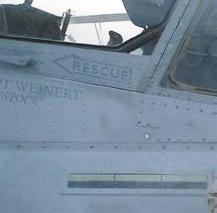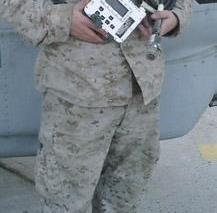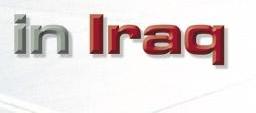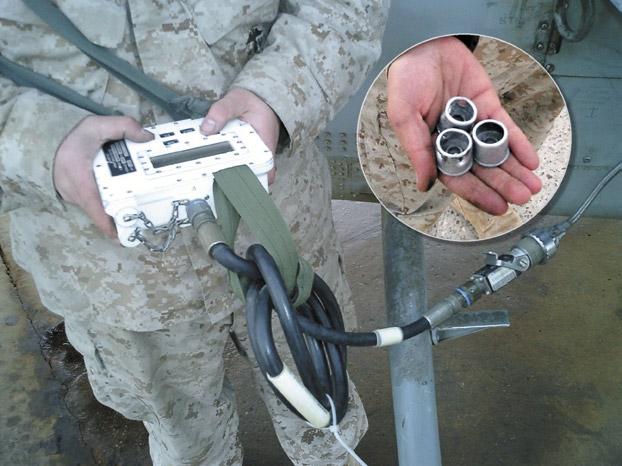
8 minute read
Chief, I Cut Myself
from MECH Fall 2006
By AN Alvin Roley
It was a rare, cold morning at NAS Lemoore, as I started my workday. I reported to the line shack and received a passdown of the day's workload. Christmas was a week away, and we were only two weeks away from deployment.
Advertisement
The squadron's flight schedule was full, with our pilots preparing to return to the carrier. As a plane-captain trainee, I was assigned the job of servicing our Super Hornets' hydraulic systems. It would be a long day.
As the flight schedule progressed, the jets began returning from their training flights. Following normal maintenance practices, I serviced the hydraulics on each aircraft after it shut down. I was using a standard PON-6. After servicing the first five aircraft, the PON-6 nearly was empty; it was time to refill the reservoir. A fellow plane-captain trainee went with me to do the job so we would have enough time to finish the post-flight maintenance before a holiday safety stand-down started.
We made our way behind the power plants shop to the hazmat locker. To expedite the task, we made a deal: He would open the cans of oil, and I would pour them into the PON-6. As he opened the cans and I filled the reservoirs, some of the lids didn't come off completely. To speed things up, I decided to pull off the lids with my hands, while wearing only flight-deck gloves.
The hazmat locker had a pair of double-palmed leather gloves and a pair of Nitrel gloves, but I decided not to use them. The leather gloves were oil-soaked. The Nitrel gloves go on under the leather gloves to protect your hands from the oil.


One can's lid was hard to remove, so I tried to get a better grip. When I did, I pressed down too hard and cut through my gloves. I suffered a deep cut to the inner part of my hand, between the index finger and thumb. The pain was intense and immediate. Upon removing my glove, I saw a lot of blood and went to rinse off my hand at the nearest sink. I quickly realized I needed help. I went back to the line shack and told my chief the whole story. He immediately sent me to the base urgent-care clinic, where I received six stitches but learned I didn't have any permanent damage to my hand. Upon my return to the hangar, the squadron safety officer and the safety petty officer were happy to hear the injury would heal, but they were curious to hear how it had happened. I felt awkward revealing the details because I knew I was at fault. I had misused PPE. I also felt bad for letting down my shop; I spent two critical weeks on light duty. I took away three important lessons: • PPE is available to prevent injuries or to lessen the severity of an injury. • If something is wrong with the PPE provided, or if you have questions about it, ask your chain of command. They will support you and get serviceable equipment. • Always be careful when dealing with sharp pieces of metal.
Don't be stupid—always follow the rules, and be careful, especially when doing simple tasks.
Airman Roley is a plane-captain trainee at VFA-115.
By Cpl. Richard Mendez, USMC



It was a cold night in Iraq’s Al Anbar Province, and Cobras and Hueys were launching left and right, all night long. We watched as the birds departed Al Taqaddum Air Base and disappeared into the night to support various ground units. Things had become routine—too routine.
The ordnance shop was working well together. We nearly were two-and-a-half months into our sevenmonth deployment and were becoming comfortable with the nightly events. The operational tempo was higher than anything I had experienced, but I was sure of my responsibilities as an ordnance team leader. I worked night shift the entire time, and I was feeling pretty salty on my second tour in Iraq.

Between the aircraft launches and recoveries, we continued to press with our maintenance effort. With 20 AH-1W Cobras and another 10 UH-1N Hueys on the flightline, we had enough work, but the routine had made us complacent.
We received a radio call from maintenance control, telling us to download a Cobra so other work centers could complete some maintenance tasks. All available ordnance Marines reported to the aircraft for the download. Once the Marines doing maintenance were done, we prepared to reload the aircraft—as soon as the call came from control.
A pair of high-time bomb racks needed to be removed and routed to the Intermediate Maintenance



It’s critical to make sure the cockpit, aircraft and test equipment are ready before ground checks.




Activity (IMA) for a scheduled inspection. Maintenance control told us the racks needed to be removed quickly because the aircraft would be on immediate strip alert that night. A few Marines stayed to watch the ordnance, while the rest of our crew gathered the required gear and tools and headed to aircraft 41.
We went to work removing the BRU-23 rack from station No. 3 and installed a new bomb rack. Because both racks had to be replaced, we moved an empty LAU-68 rocket launcher from station No. 2 to station No. 3, allowing us to remove and replace the other rack, as well. A call suddenly came over the radio to send an arm/de-arm crew to the hot fuel pits immediately. I assembled a qualified crew, and they quickly headed to the pits, located half a mile or so away. With the de-arm crew in the fuel pits, the remaining ordnancemen continued to remove the remaining rack from station No. 2. We almost were finished when we received another call from control, telling us we needed to finish up and make sure the Cobra was safe for flight.
We did that task, took an inventory of our tools, and left. Control said they would call us back to let us know when we could install the other BRU rack. We made our way back to the Cobra we had downloaded to see if it was ready to be reloaded; however, other shops still were busy working on various systems.
I noticed two ordnance Marines heading toward aircraft 41 with the new BRU rack. I thought to myself, “I must have missed the call from control,” deciding to assist the Marines with the task to finish quickly. With the installation complete, only an operational check of the jettison system remained. I climbed into the rear seat of the Cobra to set up the switches for this check, just like I’d done hundreds of times before. After directing the other Marine with me to set up the AWM-102 test set and to tell me when he was ready, I
Before using a test set for jettison checks, remove the cartridges.

turned on battery power and started pushing the jettison button. My partner said he didn’t get the correct display on the test set, so I climbed out of the cockpit to verify the test set was connected properly. It was, so we decided to check it again.
This time when I pressed the jettison button, I heard a pop that sounded like a panel had fallen off the other side of the aircraft. We went to investigate, and, as we came around the side, we could smell gunpowder. That’s when I realized I had not removed the cartridge-actuated devices (CADs) from the aircraft. We checked all four stations to see how many CADs were expended and verified that three of the six CADs installed on the aircraft had discharged.
The racks had safety pins installed or were locked to prevent jettison, so no launchers came off the aircraft. Looking back at my actions, I realize the mistakes that led to this incident. I did not have a qualityassurance safety observer verify the helicopter was not loaded before our operational checks. I also did not have the required checklists.
I never thought something like this ever would happen to me, but it did. I’ve always been a professional and have done by-the-book maintenance. On this day, however, my actions could have resulted in serious injury had someone been near the racks when those CADs went off and had the safety pins been uninstalled.
Because of our high operational tempo, I was lulled into thinking I could cut out required steps and procedures to save a couple of valuable minutes. Instead of saving time, I created more work for everyone. We had to inspect and clean the racks, fill out reports, and take care of additional paperwork. I was held responsible for my actions and learned the hard way about following maintenance procedures.
Cpl. Mendez works in the ordnance shop at HMLA-369 and currently is deployed in Iraq.










